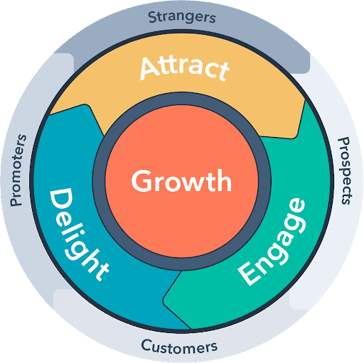Inbound Marketing Blog
for Manufacturers and Healthcare Companies
Inbound vs. PPC: Is PPC Inbound or Outbound Marketing?

The farmboy and the princess. The swordsman and the giant. The grandfather and his grandson.
Sometimes the oddest pairings make the best relationships, especially when you at first can’t see how they fit together. The Princess Bride teaches us this.
Take inbound marketing and pay-per-click advertising. Is pay-per-click (PPC) advertising a part of inbound marketing strategy, or is it considered outbound marketing?
It’s both… and neither.
Depending on your perspective, PPC advertising can be seen as both “push” – interruptive, outbound marketing – and “pull” – attracting, inbound marketing.
The real point is not whether PPC is inbound or outbound marketing, but whether you are using it effectively (if at all!) in your marketing strategy.
Using PPC advertising as part of your digital marketing strategy, especially when complementing an inbound approach, is highly effective for manufacturers looking to reach new customers, nurture existing prospects, or re-engage past clients.
What is Inbound Marketing?
Inbound marketing is an approach to building relationships with clients in a more customer-centric manner. Through a variety of tactics that are part of a well-thought-out strategy, inbound marketing aims to reach prospects on their terms, providing them a chance to find your product or service based on their needs.
The main purveyor of inbound marketing is Hubspot, and if you’re interested they offer a great course on inbound marketing.

But, if you’re pressed for time, inbound can be summed up into three stages:
- Attract: provide value to potential customers with online content – including blog articles, downloadable content, and social media posts – to establish trust as a topic expert.
- Engage: identify potential customers’ problems and offer solutions tailored to their needs so they are more likely to convert.
- Delight: keep the relationship going with great customer service and support – existing customers who provide reviews and referrals help attract new customers.
What Inbound Marketing Isn’t
Think of inbound marketing as a Bath & Body Works store – cozy with attractive displays and rich fragrances wafting out inviting customers to browse and sample everything.
Contrast that with the traditional department store perfume counter where a salesperson working on commission would try to convince you to stop moving long enough for them to spray you with an unknown scent – that’s outbound.
Or, to borrow from The Princess Bride, inbound marketing is Princess Buttercup’s dream of being presented as the new queen; outbound marketing is the interrupting hag that turns the dream into a nightmare.
What is Pay-Per-Click?
You probably already know the definition of pay-per-click is in its name: advertisers pay a search service (usually Google) for customers to click on their advertisements.
PPC allows for incredible targeting in:
- Customer demographics
- Customer profiles
- Location
- Search terms (customer intent)
Resource: SEMRush offers a helpful PPC primer for more in-depth information, while we will only cover the basics here.
Effective PPC strategy, especially for manufacturers, starts with S.M.A.R.T. goal setting (specific, measurable, achievable, relevant/realistic, time-bound).
Like the magic pill Miracle Max makes to bring Westley back from the mostly dead, PPC is best used with a specific goal. Consider it for a product launch, a trade show, or a specific geographic area; but not for the broad goal of getting conversions.
Similar to Miracle Max’s magic pill, it doesn’t take long to see results. Most PPC campaigns are approved by their platform within hours of submission and start getting clicks.
Great PPC campaign management focuses on keywords, and their:
- Intent
- Volume
- Competition
- Cost
Getting the keywords right requires knowledge of your audience, their pain points and what they’re searching for – which brings us back to inbound marketing.
[How] Do Inbound and PPC Fit Together?
Though it’s common to think you’re going to implement either an inbound marketing strategy or a PPC strategy (one or the other), it’s simply not the case. The two are not mutually exclusive.
Like Inigo Montoya and Fezzik, they work together with grace and agility (inbound), and brute force (PPC).
Since inbound content strategy is most often implemented in the attract stage (remember, your blog articles, downloadable content offers, and social media), it goes hand-in-hand with SEM and PPC strategy.
Targeting specific keywords (based on your customer insights) in your content helps you rank organically in search results. Pairing keyword-focused organic content with the right targeted PPC campaign makes both your content and PPC advertising more effective.
Your website and resources are the heart and soul of an inbound campaign. Your organic content builds over time and grows in leads – it’s what we call evergreen. PPC, however, is a more short-term tactic in some respects. We tend to view it as temporary or specific – think: seasonal.
Partner with Inbound Marketing Strategy and PPC Experts
Do you feel like a miracle worker yet, or would you rather be off adventuring? Do you feel better answering the question: Is PPC inbound or outbound marketing?
We understand if you’re not someone who is deeply knowledgeable and experienced in the areas of running B2B ad campaigns.
Choosing between an inbound approach or an outbound approach is a challenge. Add to that determining where and whether PPC fits, and it feels nearly impossible – like taking on a castle full of guards to rescue a princess.
That’s why sometimes you need a little help to get over the most challenging humps (or Humperdincks).
Does Your Noble Cause Need Help?
Our team leverages inbound, PPC, and SEM strategies to help clients nurture and convert leads.
 Would you like us to assess where you’re at in your inbound journey? Let us help with the miracles. Contact Alec – and have fun storming the castle!
Would you like us to assess where you’re at in your inbound journey? Let us help with the miracles. Contact Alec – and have fun storming the castle!
Our Blogs, Direct to Your Inbox!
How to Audit your Online Marketing
If you are executing digital marketing, congratulations! You are most likely already one step ahead of your competition, and making strides to meaningfully connect with prospects online. But, how do you know if you’re seeing continual success year over year, and improving your metrics?
Without the tools in place to analyze and benchmark your efforts, it is impossible to scale your online marketing and ensure continuous success.


